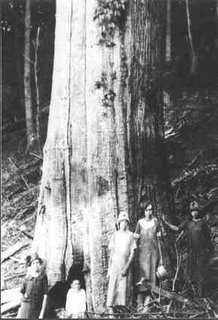Castanea Dentata
A critical commodity to the rural Appalachian economy, its wood was straight-grained, easily worked, lightweight and highly rot-resistant which made it prized for everything from lumber for home construction to furniture to split-rail fencing. Structures that date to the turn of the century were likely constructed of American Chestnut. The tree also produced nuts that were highly valuable and sought after by both people and wildlife.
However, an invasive species of fungus introduced from Asia brought a catastrophic blight to the American chestnut. First found in 1902 in New York's Bronx Zoo, the blight spread like wildfire throughout the east and within 40 years brought devastation the tree.
Specimens can still be found in the wild, but seldom greater than 20 feet tall and 6 inches in diameter. Two of the largest surviving American Chestnut trees are in Jackson County, Tennessee. One is the state champion and has a diameter of 61 cm (24 in) and a height of 23 meters (75 ft) and the other tree is nearly as large.
On May 18, 2006, a biologist with the Georgia Department of Natural Resources spotted a stand of several trees near Warm Springs, Georgia. One of the trees is approximately 20-30 years old and 13 meters (40 ft) tall and is the southernmost American Chestnut tree known to be flowering and producing nuts. Another large tree was found in Talladega National Forest, Alabama on June 2006. It is 26 meters (85 ft) tall with a diameter of 35 centimeters (14 in).
A combination of factors may account for the survival of these relatively large American Chestnut trees including low levels of blight resistance, hypovirulence (the attacking blight fungus is weakened by a virus), and good site conditions. In some cases, large chestnut trees have just been lucky and have not yet been exposed to the blight-causing spores.
Several organizations are working on restoring the American Chestnut to its historic eastern range.
The American Chestnut Foundation
Probably the most notable organization working on behalf of the American Chestnut. Based in Bennington, Vermont, ACF seeks to restore the American Chestnut by creating a blight-resistant American Chestnut by "backcrossing" blight resistance from the Chinese chestnut into the American Chestnut, while maintaining the American Chestnut’s characteristics. A blight-resistant American Chestnut tree is expected to be ready soon for forest test-planting and for wider distribution within the next decade. An American Chestnut from ACF's research farm in Meadowview, VA was planted on the White House lawn during last year's Arbor Day celebration.
American Chestnut Cooperators' Foundation
The American Chestnut Cooperators' Foundation's goal is to raise funds to support graduate and undergraduate student research projects at Virginia Tech's Department of Plant Pathology, Physiology & Weed Science, and at Concord College, West Virginia. The research makes possible seedling and nut distributions from an all-American breeding program to restore American Chestnuts to native forests.
The Canadian Chestnut Council
The Canadian Chestnut Council is a charitable organization that has been actively involved since 1988 in the development and implementation of numerous objectives in support of the American Chestnut. CCC acts as an information network for coordinating the support efforts by various Chestnut enthusiasts and research scientists across Ontario and Canada, and to communicate with similar groups in the United States and elsewhere.
Also noteworthy is an article on the American Chestnut in National Geographic Magazine.





2 comments:
This is a great bit of history. My family's home and our ante bellum General Store are built primarily with American Chestnut - not the framing, but all the interior finish. The grain is beautifully straight, and the wood has obviously withstood more than 120 years of life as a construction material. Along with the oak hardwood flooring, Chestnut was one of the most common varieties for finished wall construction in this area.
Many homes that are more than 50 years old (and even some younger) in Eastern Tennessee - particularly in Greene and Hawkins counties, where logging was a chief trade - are living monuments to the American Chestnut.
If you happen to live in, or know someone who lives in, a turn-of-the-century home, check the finish wood. If your board planks are more than 13" wide with straight grain and a blanched tan to blanched brown shade, you probably have Chestnut.
Thanks for the write-up, Jeremy.
This is great. I really like it.
Thank you so much for sharing.
Post a Comment